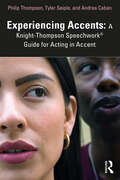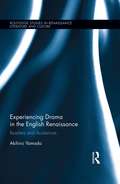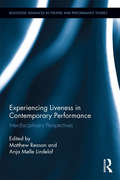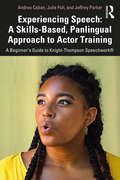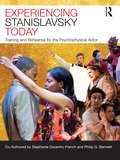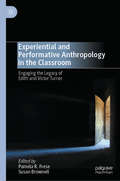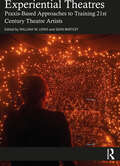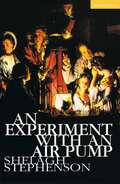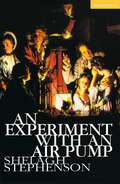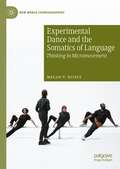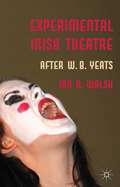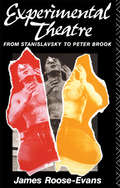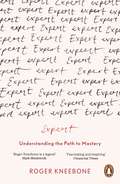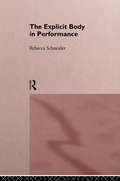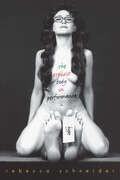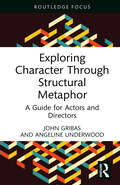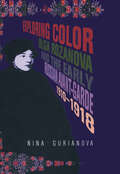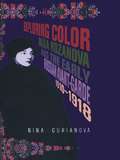- Table View
- List View
Experiencing Accents: A Knight-Thompson Speechwork® Guide for Acting in Accent
by Philip Thompson Tyler Seiple Andrea CabanExperiencing Accents: A Knight-Thompson Speechwork® Guide for Acting in Accent presents a comprehensive and systematic approach to accent acquisition for actors. It lays out an accessible and effective set of tools, exercises, and theoretical frameworks grounded in current linguistic science, as well as more than two decades of teaching, actor training, and coaching developed by Knight-Thompson Speechwork®. This book dismantles the notions that accents exist on a spectrum of good and bad or that "neutral," "general," or "standard" can serve as ideals for speech. By de-centering elitist and authoritarian worldviews, it gives actors a path to mobilize their innate language abilities to acquire any accent, relying on descriptive and experiential knowledge. The innovative approach of the Four Ps – People, Prosody, Posture, and Pronunciation – builds cultural competence that honors accents as they exist in the world, increases the physical and perceptive skills of the actor, and provides a rich variety of applications to encourage fluid and embodied accent performance. Each of the Four Ps are investigated and practiced separately and then synthesized in the art of the performer, allowing actors to address the complexity of acting in accent through a deliberate and sequential layering of skills, rendering the final expression of their technique meticulously accurate and deeply authentic. Organized into fifteen modules to correspond with a typical semester, Experiencing Accents is perfect for Theatre students in voice, speech, and accents courses, along with working actors interested in improving their accent work.
Experiencing Drama in the English Renaissance: Readers and Audiences (Routledge Studies in Renaissance Literature and Culture)
by Akihiro YamadaThis book investigates the complex interactions, through experiencing drama, of readers and audiences in the English Renaissance. Around 1500 an absolute majority of population was illiterate. Henry VIII’s religious reformation changed this cultural structure of society. ‘The Act for the Advancement of True Religion’ of 1543, which prohibited the people belonging to the lower classes of society as well as women from reading the Bible, rather suggests that there already existed a number of these folks actively engaged in reading. The Act did not ban the works of Chaucer and Gower and stories of men’s lives – good reading for them. The successive sovereigns’ educational policies also contributed to rising literacy. This trend was speeded up by London’s growing population which invited the rise of commercial playhouses since 1567. Every citizen saw on average about seven performances every year: that is, about three per cent of London’s population saw a performance a day. From 1586 onwards merchants’ appearance in best-seller literature began to increase while stage representation of reading/writing scenes also increased and stimulated audiences towards reading. This was spurred by standardisation of the printing format of playbooks in the early 1580s and play-minded readers went to playbooks, eventually to create a class of playbook readers. Late in the 1590s, at last, playbooks matched with prose writings in ratio to all publications. Parts I and II of this book discuss these topics in numerical terms as much as possible and Part III discusses some monumental characteristics of contemporary readers of Chapman, Ford, Marston and Shakespeare.
Experiencing Drama in the English Renaissance: Readers and Audiences (Routledge Studies in Renaissance Literature and Culture)
by Akihiro YamadaThis book investigates the complex interactions, through experiencing drama, of readers and audiences in the English Renaissance. Around 1500 an absolute majority of population was illiterate. Henry VIII’s religious reformation changed this cultural structure of society. ‘The Act for the Advancement of True Religion’ of 1543, which prohibited the people belonging to the lower classes of society as well as women from reading the Bible, rather suggests that there already existed a number of these folks actively engaged in reading. The Act did not ban the works of Chaucer and Gower and stories of men’s lives – good reading for them. The successive sovereigns’ educational policies also contributed to rising literacy. This trend was speeded up by London’s growing population which invited the rise of commercial playhouses since 1567. Every citizen saw on average about seven performances every year: that is, about three per cent of London’s population saw a performance a day. From 1586 onwards merchants’ appearance in best-seller literature began to increase while stage representation of reading/writing scenes also increased and stimulated audiences towards reading. This was spurred by standardisation of the printing format of playbooks in the early 1580s and play-minded readers went to playbooks, eventually to create a class of playbook readers. Late in the 1590s, at last, playbooks matched with prose writings in ratio to all publications. Parts I and II of this book discuss these topics in numerical terms as much as possible and Part III discusses some monumental characteristics of contemporary readers of Chapman, Ford, Marston and Shakespeare.
Experiencing Liveness in Contemporary Performance: Interdisciplinary Perspectives (Routledge Advances in Theatre & Performance Studies)
by Matthew Reason Anja Mølle LindelofThis volume brings together dynamic perspectives on the concept of liveness in the performing arts, engaging with the live through the particular analytical focus of audiences and experience. The status and significance of the live in performance has become contested: perceived as variously as a marker of ontological difference, a promotional slogan, or a mystical evocation of cultural value. Moving beyond debates about the relationship between the live and the mediated, this collection considers what we can know and say about liveness in terms of processes of experiencing and processes of making. Drawing together contributions from theatre, music, dance, and performance art, it takes an interdisciplinary approach in asking not what liveness is, but how it matters and to whom. The book invites readers to consider how liveness is produced through processes of audiencing - as spectators bring qualities of (a)liveness into being through the nature of their attention - and how it becomes materialized in acts of performance, acts of making, acts of archiving, and acts of remembering. Theoretical chapters and practice-based reflections explore liveness, eventness and nowness as key concepts in a range of topics such as affect, documentation, embodiment, fandom, and temporality, showing how the relationship between audience and event is rarely singular and more often malleable and multiple. With its focus on experiencing liveness, this collection will be of interest to disciplines including performance, audience and cultural studies, visual arts, cinema, and sound technologies.
Experiencing Liveness in Contemporary Performance: Interdisciplinary Perspectives (Routledge Advances in Theatre & Performance Studies)
by Matthew Reason Anja Mølle LindelofThis volume brings together dynamic perspectives on the concept of liveness in the performing arts, engaging with the live through the particular analytical focus of audiences and experience. The status and significance of the live in performance has become contested: perceived as variously as a marker of ontological difference, a promotional slogan, or a mystical evocation of cultural value. Moving beyond debates about the relationship between the live and the mediated, this collection considers what we can know and say about liveness in terms of processes of experiencing and processes of making. Drawing together contributions from theatre, music, dance, and performance art, it takes an interdisciplinary approach in asking not what liveness is, but how it matters and to whom. The book invites readers to consider how liveness is produced through processes of audiencing - as spectators bring qualities of (a)liveness into being through the nature of their attention - and how it becomes materialized in acts of performance, acts of making, acts of archiving, and acts of remembering. Theoretical chapters and practice-based reflections explore liveness, eventness and nowness as key concepts in a range of topics such as affect, documentation, embodiment, fandom, and temporality, showing how the relationship between audience and event is rarely singular and more often malleable and multiple. With its focus on experiencing liveness, this collection will be of interest to disciplines including performance, audience and cultural studies, visual arts, cinema, and sound technologies.
Experiencing Speech: A Beginner's Guide to Knight-Thompson Speechwork®
by Andrea Caban Julie Foh Jeffrey ParkerExperiencing Speech: A Skills-Based, Panlingual Approach to Actor Training is a beginner’s guide to Knight-Thompson Speechwork®, a method that focuses on universal and inclusive speech training for actors from all language, racial, cultural, and gender backgrounds and identities. This book provides a progression of playful, practical exercises designed to build a truly universal set of speech skills that any actor can use, such as the ability to identify, discern, and execute every sound found in every language on the planet. By observing different types of flow through the vocal tract, vocal tract anatomy, articulator actions, and how these components can be combined, readers will understand and recreate the process by which language is learned. They will then be introduced to the International Phonetic Alphabet (IPA) and will practice using the IPA for narrow transcription of speech sounds. The book also offers both an intellectual and physical understanding of oral posture and how it contributes to vocal characterization and accent work. This approach to speech training is descriptive, giving students a wide and diverse set of speech sounds and skills to utilize for any character in any project, and it establishes a foundation for future accent study and acquisition. Experiencing Speech: A Skills-Based, Panlingual Approach to Actor Training is an excellent resource for teachers and students of speech and actor training, as well as aspiring actors looking to diversify their speech skills.
Experiencing Speech: A Beginner's Guide to Knight-Thompson Speechwork®
by Andrea Caban Julie Foh Jeffrey ParkerExperiencing Speech: A Skills-Based, Panlingual Approach to Actor Training is a beginner’s guide to Knight-Thompson Speechwork®, a method that focuses on universal and inclusive speech training for actors from all language, racial, cultural, and gender backgrounds and identities. This book provides a progression of playful, practical exercises designed to build a truly universal set of speech skills that any actor can use, such as the ability to identify, discern, and execute every sound found in every language on the planet. By observing different types of flow through the vocal tract, vocal tract anatomy, articulator actions, and how these components can be combined, readers will understand and recreate the process by which language is learned. They will then be introduced to the International Phonetic Alphabet (IPA) and will practice using the IPA for narrow transcription of speech sounds. The book also offers both an intellectual and physical understanding of oral posture and how it contributes to vocal characterization and accent work. This approach to speech training is descriptive, giving students a wide and diverse set of speech sounds and skills to utilize for any character in any project, and it establishes a foundation for future accent study and acquisition. Experiencing Speech: A Skills-Based, Panlingual Approach to Actor Training is an excellent resource for teachers and students of speech and actor training, as well as aspiring actors looking to diversify their speech skills.
Experiencing Stanislavsky Today: Training and Rehearsal for the Psychophysical Actor
by Stephanie Daventry French Philip G. BennettThis pioneering introduction to Stanislavsky's methods and modes of actor training covers all of the essential elements of his System. Recreating ‘truthful’ behaviour in the artificial environment, awareness and observation, psychophysical work, given circumstances, visualization and imagination, and active analysis are all introduced and explored. Each section of the book is accompanied by individual and group exercises, forming a full course of study in the foundations of modern acting. A glossary explains the key terms and concepts that are central to Stanislavsky’s thinking at a glance. The book’s companion website is full of downloadable worksheets and resources for teachers and students. Experiencing Stanislavsky Today is enhanced by contemporary findings in psychology, neuroscience, anatomy and physiology that illuminate the human processes important to actors, such as voice and speech, creativity, mind-body connection, the process and the production of emotions on cue. It is the definitive first step for anyone encountering Stanislavsky’s work, from acting students exploring his methods for the first time, to directors looking for effective rehearsal tools and teachers mapping out degree classes.
Experiencing Stanislavsky Today: Training and Rehearsal for the Psychophysical Actor
by Stephanie Daventry French Philip G. BennettThis pioneering introduction to Stanislavsky's methods and modes of actor training covers all of the essential elements of his System. Recreating ‘truthful’ behaviour in the artificial environment, awareness and observation, psychophysical work, given circumstances, visualization and imagination, and active analysis are all introduced and explored. Each section of the book is accompanied by individual and group exercises, forming a full course of study in the foundations of modern acting. A glossary explains the key terms and concepts that are central to Stanislavsky’s thinking at a glance. The book’s companion website is full of downloadable worksheets and resources for teachers and students. Experiencing Stanislavsky Today is enhanced by contemporary findings in psychology, neuroscience, anatomy and physiology that illuminate the human processes important to actors, such as voice and speech, creativity, mind-body connection, the process and the production of emotions on cue. It is the definitive first step for anyone encountering Stanislavsky’s work, from acting students exploring his methods for the first time, to directors looking for effective rehearsal tools and teachers mapping out degree classes.
Experiential and Performative Anthropology in the Classroom: Engaging the Legacy of Edith and Victor Turner
by Pamela R. Frese Susan BrownellThe contributors gathered here revitalize “ethnographic performance”—the performed recreation of ethnographic subject matter pioneered by Victor and Edith Turner and Richard Schechner—as a progressive pedagogy for the 21st century. They draw on their experiences in utilizing performances in a classroom setting to facilitate learning about the diversity of culture and ways of being in the world. The editors, themselves both students of Turner at the University of Virginia, and Richard Schechner share recollections of the Turners’ vision and set forth a humanistic pedagogical agenda for the future. A detailed appendix provides an implementation plan for ethnographic performances in the classroom.
Experiential Theatres: Praxis-Based Approaches to Training 21st Century Theatre Artists
by William W. Lewis Sean BartleyExperiential Theatres is a collaboratively edited and curated collection that delivers key insights into the processes of developing experiential performance projects and the pedagogies behind training theatre artists of the twenty-first century. Experiential refers to practices where the audience member becomes a crucial member of the performance world through the inclusion of immersion, participation, and play. As technologies of communication and interactivity have evolved in the postdigital era, so have modes of spectatorship and performance frameworks. This book provides readers with pedagogical tools for experiential theatre making that address these shifts in contemporary performance and audience expectations. Through case studies, interviews, and classroom applications the book offers a synthesis of theory, practical application, pedagogical tools, and practitioner guidance to develop a praxis-based model for university theatre educators training today’s theatre students. Experiential Theatres presents a holistic approach for educators and students in areas of performance, design, technology, dramaturgy, and theory to help guide them through the processes of making experiential performance.
Experiential Theatres: Praxis-Based Approaches to Training 21st Century Theatre Artists
by William W. Lewis Sean BartleyExperiential Theatres is a collaboratively edited and curated collection that delivers key insights into the processes of developing experiential performance projects and the pedagogies behind training theatre artists of the twenty-first century. Experiential refers to practices where the audience member becomes a crucial member of the performance world through the inclusion of immersion, participation, and play. As technologies of communication and interactivity have evolved in the postdigital era, so have modes of spectatorship and performance frameworks. This book provides readers with pedagogical tools for experiential theatre making that address these shifts in contemporary performance and audience expectations. Through case studies, interviews, and classroom applications the book offers a synthesis of theory, practical application, pedagogical tools, and practitioner guidance to develop a praxis-based model for university theatre educators training today’s theatre students. Experiential Theatres presents a holistic approach for educators and students in areas of performance, design, technology, dramaturgy, and theory to help guide them through the processes of making experiential performance.
An Experiment With An Air Pump (Modern Plays)
by Shelagh StephensonShelagh Stephenson's daring and thoughtful new play1799 - On the eve of a new century, the house buzzes with scientific experiments, furtive romance and farcical amateur dramatics. 1999 - In a world of scientific chaos, cloning and genetic engineering, the cellar of the same house reveals a dark secret buried for 200 years.An Experiment with an Air Pump was joint recipient of the 1997 Margaret Ramsay Award and premiered at The Royal Exchange Theatre Company, Manchester in February 1997. Due for a major London production in autumn 1998. Her previous play The Memory of Water won the 1996 Writers' Guild Award for Best Original Radio Play and the 1997 Sony Award for Best Original Drama
An Experiment With An Air Pump: A Memory Of Water; Five Kinds Of Silence; An Experiment With An Air Pump; Ancient Lights (Modern Plays)
by Shelagh StephensonShelagh Stephenson's daring and thoughtful new play1799 - On the eve of a new century, the house buzzes with scientific experiments, furtive romance and farcical amateur dramatics. 1999 - In a world of scientific chaos, cloning and genetic engineering, the cellar of the same house reveals a dark secret buried for 200 years.An Experiment with an Air Pump was joint recipient of the 1997 Margaret Ramsay Award and premiered at The Royal Exchange Theatre Company, Manchester in February 1997. Due for a major London production in autumn 1998. Her previous play The Memory of Water won the 1996 Writers' Guild Award for Best Original Radio Play and the 1997 Sony Award for Best Original Drama
Experimental Dance and the Somatics of Language: Thinking in Micromovement (New World Choreographies)
by Megan V. NicelyThis book is about dance’s relationship to language. It investigates how dance bodies work with the micromovements elicited by language’s affective forces, and the micropolitics of the thought-sensations that arise when movement and words accompany one another within choreographic contexts. Situating itself where theory meets practice—the zone where ideas arise to be tested, the book draws on embodied research in practices within the lineages of American postmodern dance and Japanese butoh, set in dialog with affect-based philosophies and somatics. Understanding that language is felt, both when uttered and when unspoken, this book speaks to the choreographic thinking that takes place when language is considered a primary element in creating the sensorium.
Experimental Irish Theatre: After W.B. Yeats
by I. WalshThis book examines experimental Irish theatre that ran counter to the naturalistic 'peasant' drama synonymous with Irish playwriting. Focusing on four marginalised playwrights after Yeats, it charts a tradition linking the experimentation of the early Irish theatre movement with the innovation of contemporary Irish and international drama.
Experimental Theatre: From Stanislavsky to Peter Brook
by James Roose-Evans`It is a pleasure to read. Well-written, free of cant, impressively wide-ranging. The book is really an introduction to the avant-garde.' - John Lahr
Experimental Theatre: From Stanislavsky to Peter Brook
by James Roose-Evans`It is a pleasure to read. Well-written, free of cant, impressively wide-ranging. The book is really an introduction to the avant-garde.' - John Lahr
Expert: Understanding the Path to Mastery
by Roger Kneebone'Roger Kneebone is a legend' Mark Miodownik, author of Stuff Matters'If you want to do anything better, from surgery to embroidery, you can learn something from this book' Christopher Peters, Imperial College LondonWhat could a lacemaker have in common with vascular surgeons? A Savile Row tailor with molecular scientists? A fighter pilot with jazz musicians? At first glance, very little. But Roger Kneebone is the expert on experts, having spent a lifetime finding the connections.In Expert, he combines his own experiences as a doctor with insights from extraordinary people and cutting-edge research to map out the path we're all following - from 'doing time' as an Apprentice, to developing your 'voice' and taking on responsibility as a Journeyman, to finally becoming a Master and passing on your skills. As Kneebone shows, although each outcome is different, the journey is always the same. Whether you're developing a new career, studying a language, learning a musical instrument or simply becoming the person you want to be, this ground-breaking book reveals the path to mastery.'The doctor stitching together medicine and art' Guardian 'Kneebone is our foremost expert on expertise. Expert is a desperately important book at a moment when we've begun to wonder just what we might still be good at' Ken Arnold, Wellcome Collection 'Superbly written, passionately argued and very necessary' Tim Ingold, University of Aberdeen 'Whisper it quietly, but post COVID-19, there is a growing realization that experts do matter' Susan Standring, King's College London
The Explicit Body in Performance
by Rebecca SchneiderThe Explicit Body in Performance interrogates the avant-garde precedents and theoretical terrain that combined to produce feminist performance art. Among the many artists discussed are: * Carolle Schneemann * Annie Sprinkle * Karen Finley * Robbie McCauley * Ana Mendieta * Ann Magnuson * Sandra Bernhard * Spiderwoman Rebecca Schneider tackles topics ranging across the 'post-porn modernist movement', New Right censorship, commodity fetishism, perspectival vision, and primitivism. Employing diverse critical theories from Benjamin to Lacan to postcolonial and queer theory, Schneider analyses artistic and pop cultural depictions of the explicit body in late commodity capitalism. The Explicit Body in Performance is complemented by extensive photographic illustrations and artistic productions of postmodern feminist practitioners. The book is a fascinating exploration of how these artists have wrestled with the representational structures of desire.
The Explicit Body in Performance
by Rebecca SchneiderThe Explicit Body in Performance interrogates the avant-garde precedents and theoretical terrain that combined to produce feminist performance art. Among the many artists discussed are: * Carolle Schneemann * Annie Sprinkle * Karen Finley * Robbie McCauley * Ana Mendieta * Ann Magnuson * Sandra Bernhard * Spiderwoman Rebecca Schneider tackles topics ranging across the 'post-porn modernist movement', New Right censorship, commodity fetishism, perspectival vision, and primitivism. Employing diverse critical theories from Benjamin to Lacan to postcolonial and queer theory, Schneider analyses artistic and pop cultural depictions of the explicit body in late commodity capitalism. The Explicit Body in Performance is complemented by extensive photographic illustrations and artistic productions of postmodern feminist practitioners. The book is a fascinating exploration of how these artists have wrestled with the representational structures of desire.
Exploring Character Through Structural Metaphor: A Guide for Actors and Directors (ISSN)
by John Gribas Angeline UnderwoodExploring Character Through Structural Metaphor will help performers discover new and valuable insights into the characters they play. Grounded in a contemporary approach to understanding and applying the power of metaphor, it offers a practical guide for both actors and directors. This book introduces the idea of metaphor as a way of thinking rather than simply as clever comparison or figurative language. It demonstrates limitations of ways metaphor has traditionally been used in character development and presents a method for applying structural metaphor to discover rich, in-depth character insights. For directors, the model can serve as an option for guiding character analysis that is less individualistic and actor-specific and more wholistic and cast-inclusive, promoting stronger overall performance unity and production cohesion. In addition to offering a clear, followable guide for character analysis, the authors draw on personal experience to vividly demonstrate how applying this method for character analysis could impact performance and production. This book will be a useful addition to an actor’s or director’s set of character development resources.
Exploring Character Through Structural Metaphor: A Guide for Actors and Directors (ISSN)
by John Gribas Angeline UnderwoodExploring Character Through Structural Metaphor will help performers discover new and valuable insights into the characters they play. Grounded in a contemporary approach to understanding and applying the power of metaphor, it offers a practical guide for both actors and directors. This book introduces the idea of metaphor as a way of thinking rather than simply as clever comparison or figurative language. It demonstrates limitations of ways metaphor has traditionally been used in character development and presents a method for applying structural metaphor to discover rich, in-depth character insights. For directors, the model can serve as an option for guiding character analysis that is less individualistic and actor-specific and more wholistic and cast-inclusive, promoting stronger overall performance unity and production cohesion. In addition to offering a clear, followable guide for character analysis, the authors draw on personal experience to vividly demonstrate how applying this method for character analysis could impact performance and production. This book will be a useful addition to an actor’s or director’s set of character development resources.
Exploring Color: Olga Rozanova and the Early Russian Avant-Garde 1910-1918
by Nina GurianovaThis is an examination of the paintings, books, poetry and theoretical work of Russian avant-garde artist, Olga Rozanova. The text assesses Rozanova's life and work, aiming to recreate the spirit of the counterculture milieu that contributed to the transformation of 20th-century art.
Exploring Color: Olga Rozanova and the Early Russian Avant-Garde 1910-1918
by Nina GurianovaThis is an examination of the paintings, books, poetry and theoretical work of Russian avant-garde artist, Olga Rozanova. The text assesses Rozanova's life and work, aiming to recreate the spirit of the counterculture milieu that contributed to the transformation of 20th-century art.
